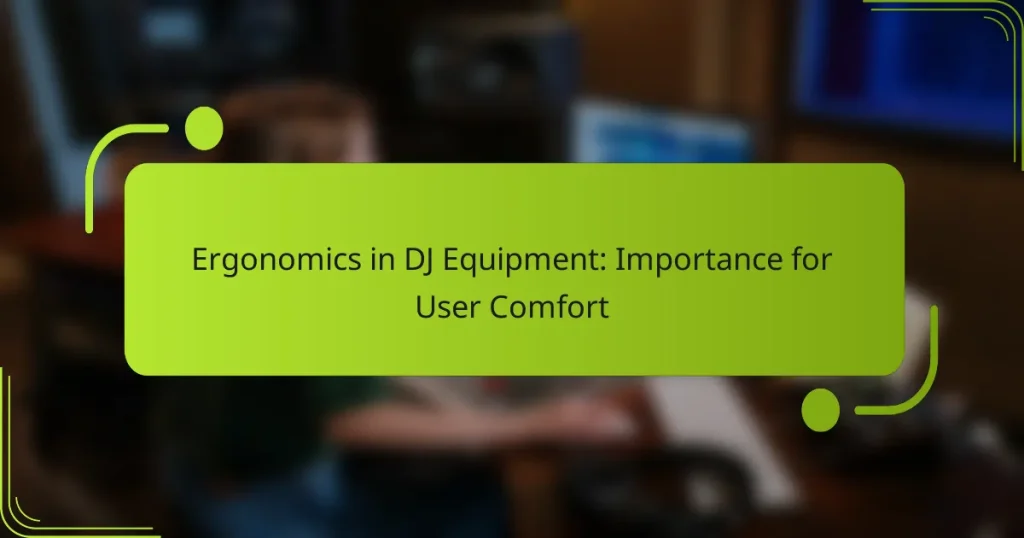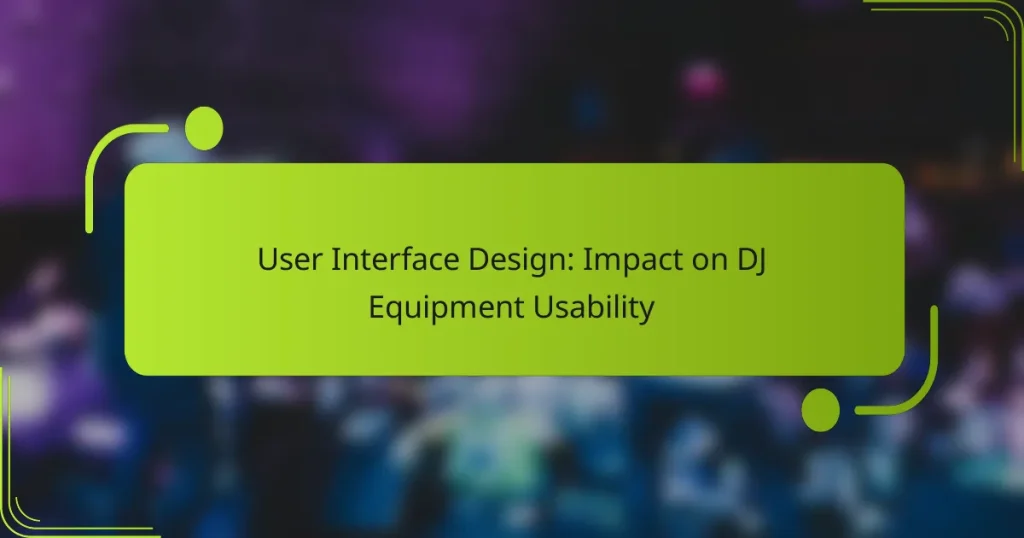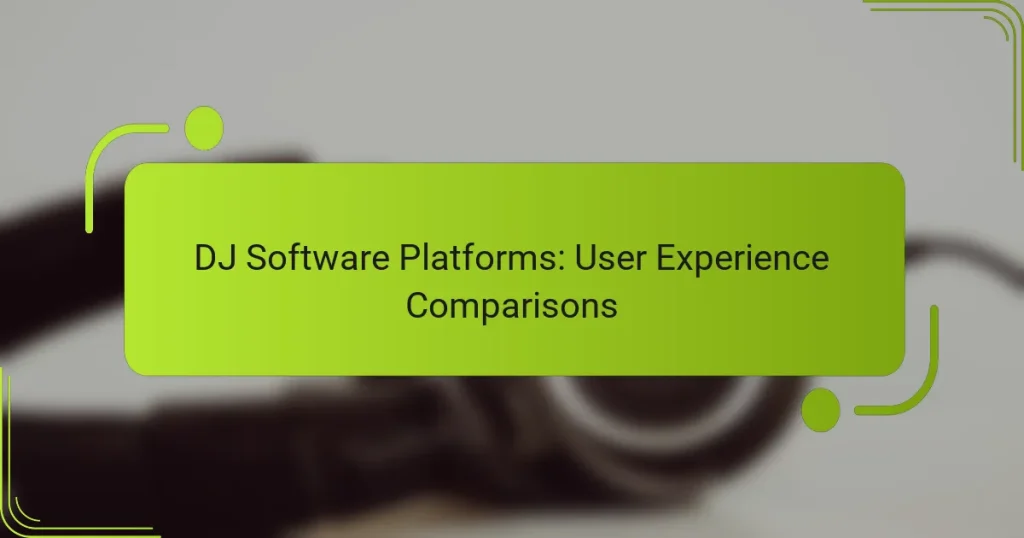Choosing the right DJ equipment is essential for both beginners and experienced DJs, as user experience and interface can greatly influence performance. Opt for controllers that are intuitive and feature-rich, ensuring they enhance creativity without adding unnecessary complexity. Prioritizing build quality, software compatibility, and portability will further improve usability during gigs and practice sessions.
Ergonomics in DJ Equipment: Importance for User Comfort
DJ Gear: Choosing Based on User Feedback and Reviews
Touchscreen Interfaces: Evaluation in Modern DJ Equipment
DJ Controllers: User-Friendly Features for Beginners
User Interface Design: Impact on DJ Equipment Usability
DJ Software Platforms: User Experience Comparisons
What are the best DJ equipment options for beginners?
For beginners, the best DJ equipment options are user-friendly controllers that offer essential features without overwhelming complexity. Look for devices that provide intuitive layouts, built-in tutorials, and compatibility with popular DJ software.
Pioneer DJ DDJ-400
The Pioneer DJ DDJ-400 is an excellent choice for novice DJs due to its straightforward interface and professional features. It includes a built-in sound card and is designed to work seamlessly with Rekordbox DJ software, making it easy to organize and mix tracks.
This controller features a compact layout with performance pads, allowing beginners to experiment with effects and loops. Its price typically ranges from $250 to $300, making it an affordable entry point into DJing.
Numark Mixtrack Pro FX
The Numark Mixtrack Pro FX is another solid option for beginners, offering a good balance of features and affordability. It comes with a built-in audio interface and is compatible with Serato DJ Lite, which is included with the purchase.
This controller boasts large jog wheels and dedicated effects controls, which help new DJs learn essential mixing techniques. Priced around $200, it provides great value for those starting their DJ journey.
Roland DJ-202
The Roland DJ-202 is a versatile controller that caters to beginners while providing advanced features for future growth. It includes built-in drum sounds and a sequencer, allowing users to create unique beats on the fly.
This controller is compatible with Serato DJ Lite and offers a range of performance features, including performance pads and a two-channel mixer. With a price point of approximately $300, it’s a great investment for those looking to expand their skills over time.
How does user experience impact DJ equipment selection?
User experience plays a crucial role in selecting DJ equipment, as it directly affects how easily a DJ can perform and adapt to various situations. A positive user experience can enhance creativity and efficiency, while a poor interface may hinder performance and lead to frustration.
Intuitive interfaces enhance performance
An intuitive interface allows DJs to navigate their equipment quickly and efficiently, which is essential during live performances. Features like clearly labeled controls, responsive touchscreens, and customizable layouts can significantly improve a DJ’s workflow.
For instance, equipment that offers one-touch access to frequently used functions can save valuable time, allowing DJs to focus more on their music rather than on adjusting settings. When evaluating gear, consider how easily you can access essential features and whether the layout feels natural.
Feedback from experienced DJs
Experienced DJs often provide insights that can guide equipment selection, highlighting the importance of user experience. Their feedback typically emphasizes the need for reliability, ease of use, and the ability to integrate with other devices.
Listening to reviews and testimonials can help identify which brands and models consistently meet the demands of professional DJs. Look for common themes in feedback, such as the durability of controls, the responsiveness of software, and overall satisfaction with the equipment’s performance in live settings.
What features should I look for in DJ equipment?
When selecting DJ equipment, prioritize features that enhance your performance, such as build quality, software compatibility, and portability. These elements significantly impact usability and overall experience during gigs or practice sessions.
Build quality and durability
Build quality and durability are crucial for DJ equipment, as these factors determine how well the gear withstands the rigors of transport and frequent use. Look for equipment made from robust materials like metal or high-grade plastic that can endure drops and rough handling.
Consider models with reinforced components, such as knobs and faders, which are often the most used parts. Investing in gear with a solid warranty can also provide peace of mind regarding durability.
Software compatibility
Software compatibility is essential for seamless integration with your preferred DJ software, whether it’s Serato, Traktor, or Rekordbox. Ensure the equipment you choose supports the software you plan to use, as this will enhance functionality and ease of use.
Check for features like MIDI mapping and plug-and-play capabilities, which allow for quick setup and customization. Some devices may come with bundled software, providing additional value and convenience.
Portability and weight
Portability and weight are important considerations, especially for mobile DJs who frequently transport their gear. Look for lightweight options that are easy to carry without sacrificing features or performance.
Many DJ controllers and mixers are designed to be compact, often weighing between 1 to 3 kg. Consider your transport method and storage space when selecting equipment to ensure it fits your lifestyle and gigging needs.
How do I evaluate the interface of DJ equipment?
To evaluate the interface of DJ equipment, focus on how intuitive and user-friendly the controls are, as well as the clarity of visual feedback. A well-designed interface enhances performance and minimizes errors during live sets.
Layout and accessibility of controls
The layout of controls on DJ equipment significantly impacts usability. Look for a logical arrangement that allows quick access to essential functions like volume, effects, and track selection. Controls should be spaced adequately to prevent accidental adjustments, especially in high-pressure environments.
Consider the physical design as well; knobs, faders, and buttons should be easy to grip and manipulate. For example, larger knobs may be preferable for quick adjustments, while smaller buttons can be used for less frequent functions. Test the equipment in a simulated live setting to assess how easily you can navigate the controls.
Visual feedback and display quality
Visual feedback is crucial for DJs to monitor their performance effectively. High-quality displays should provide clear information on track status, BPM, and effects. Look for screens that are bright and easily readable under various lighting conditions, as this can affect your ability to perform accurately.
Additionally, consider the responsiveness of visual indicators. For instance, LED feedback on buttons should be immediate, allowing you to confirm actions without delay. Evaluate whether the display provides essential information at a glance, helping you maintain focus on your audience and the music.
What are the top-rated DJ mixers for live performances?
The top-rated DJ mixers for live performances are known for their sound quality, durability, and user-friendly interfaces. Key models include the Allen & Heath Xone:96 and the DJM-900NXS2 by Pioneer, both favored by professionals for their features and reliability.
Allen & Heath Xone:96
The Allen & Heath Xone:96 is a premium mixer that combines analog and digital technology, providing exceptional sound quality. It features a 6-channel layout with dual USB sound cards, allowing seamless integration with computers and other devices.
This mixer is particularly valued for its robust build and extensive connectivity options, including MIDI and send/return loops. DJs appreciate the customizable EQ settings and the ability to create unique soundscapes during live performances.
DJM-900NXS2 by Pioneer
The DJM-900NXS2 by Pioneer is a staple in many clubs and festivals, known for its intuitive layout and high-quality audio processing. It includes a 4-channel mixer with advanced effects and a built-in sound card, making it easy to connect to various devices.
One of its standout features is the Magvel fader, which offers smooth transitions and precise control. DJs often choose this model for its reliability and the ability to handle multiple audio sources without compromising sound quality.
How do DJ controllers compare to traditional setups?
DJ controllers offer a more compact and user-friendly alternative to traditional setups, which typically involve separate turntables and mixers. While controllers integrate multiple functions into a single device, traditional setups often provide greater tactile feedback and customization options.
Portability vs. functionality
Portability is a significant advantage of DJ controllers, making them ideal for mobile DJs and small venues. Most controllers are lightweight and easy to transport, often fitting into a standard backpack, while traditional setups can require multiple cases and larger transport solutions.
However, functionality can vary between the two. DJ controllers often come with built-in sound cards and software compatibility, streamlining the setup process. In contrast, traditional setups may offer superior sound quality and more extensive control options, appealing to those who prioritize audio fidelity and hands-on manipulation.
When choosing between the two, consider your specific needs. If you frequently perform at different locations, a controller might be the best choice. For studio work or larger events where sound quality is paramount, a traditional setup could be more suitable.






